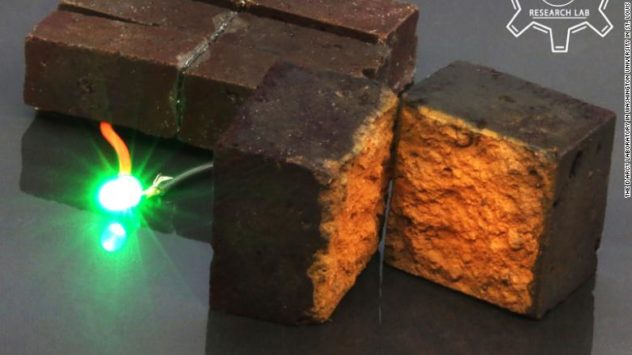© The D’Arcy Laboratory in Washington via CNN
Vocabulary:
- embed /em-BED/
[verb] — to fix something firmly into a substance
The arrow embedded itself in the tree trunk.
- advance /ad-VANS/
[verb] — move forward
The troop of soldiers advanced to the military camp later that afternoon.
- porous /PAWR-uhs/
[adjective] — something that is porous has many small holes, so liquid or air can pass through, especially slowly
Some rocks are porous; some are not.
- component /kuhm-POH-nuhnt/
[noun] — a part that combines with other parts to form something bigger
Water is a mixture of the chemical components hydrogen and oxygen atoms.
- commercially /kuh-MUR-shuhl-lee/
[adverb] — in a way that relates to the buying and selling of goods and services in order to make a profit
Their movie last December was commercially successful.
Researchers discovered that conventional bricks can be turned into energy storing devices according to studies published in the scientific journal, Nature Communications, last August 11. These bricks can be charged to store energy similar to a battery. Through a series of tests, the bricks became powerful enough to turn on LED lights. One of the authors in the study, assistant professor Julio M. D’Arcy, said that the bricks are enough to light up emergency lightings in hallways or power sensors embedded in walls. They are planning to advance to the next level by storing more energy so people could charge bigger gadgets like laptops, directly from the walls.
Researchers took advantage of bricks’ strength and structure. They pumped up gases in succession inside the porous bricks that reacted with the chemical components, coating them with PEDOT, a nanoplastic fiber that conducts electricity. Although these “smart bricks” are supercapacitors, they cannot transfer sustained energy for longer periods. Further studies are needed before these energy bricks become commercially available. Yet researchers continue to be optimistic as this technology could be developed as a new form of renewable energy.
True or False:
- Standard bricks can become energy-storing devices according to scientists.
- Assistant Professor D’Arcy said that the bricks are strong enough to power big appliances like refrigerators.
- Scientists pumped up liquids inside the porous bricks.
- These “smart bricks” are super capacitors.
- More tests are needed for the bricks to be available in the market.
Discussion Questions:
- What are the problems in using fossil fuels?
- Are there any disadvantages in using renewable energy resources? Explain your answer.
- What is the most common form of energy in your country? Is it expensive or cheap?
- What items do you recycle at home and school/work?
- Do you think houses will be more environmentally friendly in the future? Why or why not?
Express Your Opinion:
- “A transition to clean energy is about making an investment in our future.” – Gloria Reuben
- “The transition to clean energy should not be viewed as a burden to be overcome but, rather, an extraordinary job creation opportunity for the United States.” – Brad Schneider
- “Nature provides a free lunch, but only if we control our appetites.” – William Ruckelshaus
[verb] — to fix something firmly into a substance
The arrow embedded itself in the tree trunk.
[verb] — move forward
The troop of soldiers advanced to the military camp later that afternoon.
[adjective] — something that is porous has many small holes, so liquid or air can pass through, especially slowly
Some rocks are porous; some are not.
[noun] — a part that combines with other parts to form something bigger
Water is a mixture of the chemical components hydrogen and oxygen atoms.
[adverb] — in a way that relates to the buying and selling of goods and services in order to make a profit
Their movie last December was commercially successful.
Researchers took advantage of bricks’ strength and structure. They pumped up gases in succession inside the porous bricks that reacted with the chemical components, coating them with PEDOT, a nanoplastic fiber that conducts electricity. Although these “smart bricks” are supercapacitors, they cannot transfer sustained energy for longer periods. Further studies are needed before these energy bricks become commercially available. Yet researchers continue to be optimistic as this technology could be developed as a new form of renewable energy.
